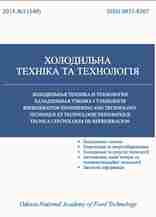ВЛАСТИВОСТІ ПЕРЕНОСУ СУМІШЕЙ ХОЛОДОАГЕНТІВ
DOI:
https://doi.org/10.15673/0453-8307.3/2014.32552Palabras clave:
Холодоагент – Суміші – В'язкість – Теплопровідність – Модель – Прогнозування.Resumen
Розроблено набір моделей для прогнозування в'язкості і теплопровідності сумішей холодоагентів. Загальна модель для в'язкості і теплопровідності використовує вид суми трьох вкладів (властивості розрідженого газу, надлишкові властивості і властивості рідини). Модель відповідних станів рекомендується для прогнозування транспортних властивостей щільного газу в діапазоні наведених густин від 0 до 2. Показано, що модель RHS забезпечує найбільш надійні результати для транспортних властивостей насиченої і стиснутої рідини в діапазоні наведених температурі від 0,5 до 0,95.
Citas
REFERENCES
1. Kestin, J., Ro, S. T., and Wakeham, W. 1972. Kinetic theory for the viscosity of gases. Physica, Vol. 58, pp. 165-174.
2.Nagaoka, K., Tanaka, Y., Kubota, H., and Makita, T. 1986. Viscosity equation for the low-pressure fluorocarbons. Int J. Thermophysics, Vol. 7, No. 5, pp. 1023-1030.
3.Geller, V. Z. and Paulaitis, M. E. 1992. The calculation and prediction of transport properties for new refrigerants and blends in refrigeration application. In Proc. of Intern. CFC and Halon Alternative Conf., Washington, DC, pp. 115-124.
4.Tanaka, Y., Matsuo, S., and Taya, S. 1995. Gaseous thermal conductivity of difluoromethane (HFC-32), pentafluoroethane (HFC-125), and their mixtures. Int. J. Thermophysics, Vol. 16, No. 1, pp. 121-131. doi: 10.1007/bf01438963
5.Geller, V. Z., Nemzer, B. V., and Cheremnykh, U. V. 2001. Thermal conductivity of mixed refrigerants R404A, R407C, R410A, and R507A. Int. J. Thermophysics, Vol. 22, No. 3, pp. 29-37.
6.Grebenkov, A., Kotelevsky, Y., and Saplitza, V. 2000. Thermal conductivity of the ternary refrigerant mixtures (R32-R125-R134a). In Proc. of 14th Symposium on Therm. Prop., Boulder, CO, pp. 256-264.
7.Bivens, D. B., Yokozeki, A., Geller, V. Z., and Paulaitis, M. E. 1993. Transport properties and heat transfer of alternatives for R502 and R22. In Proc. of ASHRAE/NIST Refrigerants Conference, Gaithersburg, MD, pp. 73-84.
8.Perkins, R. A, Schwarzberg, E, and Gao, X. 1999. Experimental thermal conductivity values for mixtures of R32, R125, R134a, and propane. NIST Report NISTIR 5093.
9.Assael, M. J., Dymond, J. H., and Polimatidou, S., K,. 1994. Correlation and prediction of dense fluid transport coefficients. VI. n-alcohols. Int. J. Thermophysics, Vol. 15, No. 2, pp. 189-201. doi: 10.1007/bf01441581
Assael, M. J., Dymond, J. H., and Polimatidou, S., K,. 1995. Correlation and prediction of dense fluid transport coefficients. VII. Refrigerants. Int. J. Thermophysics, Vol. 16, No. 3, pp. 761-772.
doi: 10.1007/bf01438861
Gao, X., Assael, M. J., Nagasaka, Y., and Nagashima, A. 2000. Prediction of the thermal conductivity and viscosity of binary and ternary HFC refrigerant mixtures. Int. J. Thermophysics, Vol. 21, No. 1, pp. 23-34.
Bleazard, J. G. and Teja, A. S. 1996. Extension of the rough hard-sphere theory for transport properties to polar liquids. Ind. Eng. Chem. Res., Vol. 35, pp. 2453-2459. doi: 10.1021/ie9507585
Laesecke, A. and Hafer, R. F. 2001. Viscosity of fluorinated propane isomers. II. Measurements of three compounds and model comparisons. J. Chem. Eng. Data, Vol. 46, No. 2, pp.433-445.
Heide, R. 1996. Viskositaet von fluessigen HFKW-Kaeltemitteln und deren Gemischen. DKV-Tagungsber. (23), Leipzig, Vol. II/1, pp. 225-241.
Ripple, D, and Matar, O. 1993. Viscosity of the saturated liquid phase of six halogenated compounds and three mixtures. J. Chem. Eng. Data, Vol. 38, No. 4, pp. 560-564. doi: 10.1021/je00012a021


